Epoxy Coating - for bonding surface friction grits to peeler rumbler drums
Summary - how to re-coat potato machine drum linings
1. Grind and Epoxy Cleaner solvent clean - surfaces must be immaculate - white cloth test
2. Warm - using a dry source of heat (not bottled gas)
3. Apply resin - Thixotropic Epoxy Resin - 3mm thick
4. Apply grit - Grit Grade 24 - at 2.5kgs per square metre.
Clicking on a blue Product Name takes you directly to the Order Pageping Page.
Coating for Peeler Surfaces - to refinish
Thixotropic Epoxy Adhesive has a strong bond, high chemical resistance, is easy to apply, and does not slump or run.
It is a no odour, two part epoxy with the consistency of Vaseline or Swarfega.
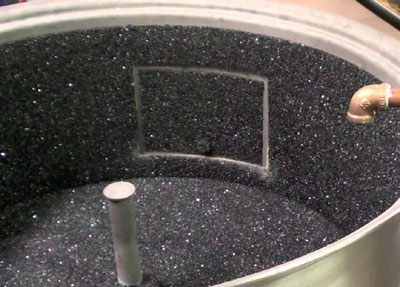
How much resin do I need for a Potato Peeler?
Thixotropic Epoxy Adhesive is supplied in the Kits in 400cc, but can be purchased separately in 1000cc packs.
Allow up to 2 litres per square metre (max. 2mm of resin thickness) for fine aggregate (24 Grade).
Kits
Small 28lb (13kg) Potato Peeling Machine allow
1 x 400cc pack of Thixotropic Epoxy Resin and 1kg of Alumac 24 Grit - £43.68 plus VAT
Large 56lb (26kg) Potato Peeling Machine allow
2 x 400cc pack of Thixotropic Epoxy Resin and 2kg of Alumac 24 Grit - £79.70 plus VAT
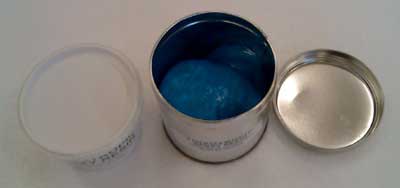
Thixotropic Epoxy 2 part - vivid blue and cream
To buy Re-Gritting Kit for a 28lb Machine - click here
To buy Re-Gritting Kit for a 56lb Machine - click here
Accessories: Epoxy Cleaner, 250cc
How to re-coat friction surfaces in Potato Peelers
1. Electrically isolate to allow full access (depending on type).
2. Strip existing grit with an angle grinder, grit blast or needle gun.
3. Strip the surface to bare metal.
4. Clean with our Epoxy Cleaner solvent to ensure no oil or grease remains in the metal.
5. Regrind to eliminate any solvent cleaner smear film. Wipe over with a clean White Cloth.
6. Wipe thoroughly again with the White Cloth - if any dark marks appear on the White Cloth repeat steps 4 - 6 until the cloth remains perfectly white.
This is the secret of success - any dirt left on, no matter how little, with reduce the resin bond and lead to bald patches, where the resin has fallen off.
6. Lay clean cardboard to catch aggregate (grit) that falls off during coating, for re-use.
7. Heat the metal with dry heat - use electrical heaters with fans. Avoid gas heating (particularly Propane), because of the water produced, which can cause condensation on the roller and loss of adhesion. Maintain background heat until the resin is completely hard. This may take up to 2 days during cold weather. Lack of heat may also allow condensation to form on the resin and the aggregate (grit) may then fail to bond properly.
8. Apply Thixotropic Epoxy Adhesive with a smooth plastic spreader or brush, to a depth of at least 75% of the average diameter of the aggregate (grit), typically Grade 24.
9. Apply clean, dust free Aggregate (grit) to the adhesive so that cover is complete, with some excess. Pat the aggregate (grit) into the resin very firmly with a clean wooden or metal object (plastering float, batten, cricket bat), or use a piece of clean hard plastic material. It is not necessary to apply another coat of resin, as long as the first coat is thick enough and the aggregate (grit) is fully bedded in. The grit must only protrude out of the resin by 1/4 of its average diameter - for example, a 3mm grit should only stick above the resin by about 0.75mm. If too much of the grit shows above the resin the bond will fail and the grit will be torn out of the resin layer, leaving bald patches.
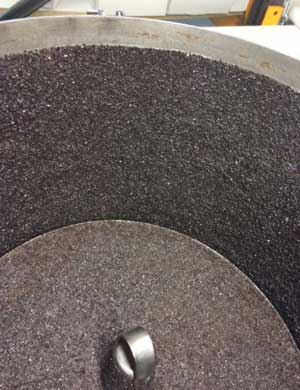
10. Leave to cure for at least 24 hours, subject to temperatures being above 15 degrees C at all times. Maintain the heating for the whole period.
To buy Re-Gritting Kit for a 28lb Machine - click here
To buy Re-Gritting Kit for a 56lb Machine - click here
Accessories: Epoxy Cleaner, 250cc
IMPORTANT NOTES - applying resin in Potato Peelers
In cold weather you must keep the metal surfaces above 5 degrees C. Below 5 degrees the resin curing will slow and curing will be delayed.
On cold, damp days condensation on the surfaces or on the resin can reduce resin and grit adhesion, so screen off the area to prevent draughts and warm up with heaters overnight.
In Winter adjust the resin temperature by placing the pots of resin in warm water.
For cleaning, use our Epoxy Cleaner, or cellulose thinners, epoxy thinners, or trichlorethylene.
To save grit, make a simple trough out of cardboard.
The machine MUST NOT BE USED until the coating is really hard. Make a test piece (of metal or wood) when the resin coating is complete. Coat the test piece with resin, without grit, and leave next to the gritted area. Test by first thumb pressure and then with a screwdriver before using the roller. When hard, the coating still continues to gain strength over several days. This is the 'curing' process and the warmer the environment the faster the curing is completed.
Click for Resins and Grits in our Order Page
TROUBLESHOOTING POTATO PEELER RE-GRIT
Resin comes off the metal - not clean enough, too cold when coated, condensation on the metal when coated, resin not fully cured.
Grit comes off the resin - condensation on the resin when gritted, grit too dusty, wet grit, grit not tamped into the resin when applied, resin not fully cured.
Resin remains sticky - not mixed fully (look for blue streaks), too cold (resin stops curing at 5C), too damp, condensation on resin before or after gritting due to low temperature, or through using bottled gas heating.
Thixotropic Epoxy Adhesive for Potato Peeler re-gritting
Available in 400cc and 1000cc (1 litre) packs, applied at about 2 to 4 litres per square metre.
Supplied in two coloured parts, vivid blue and cream - makes mixing easy: when the colour is an even light blue/grey the product is properly mixed.
To buy Re-Gritting Kit for a 28lb Machine - click here
To buy Re-Gritting Kit for a 56lb Machine - click here
Accessories: Epoxy Cleaner, 250cc
Click for Resins and Grits in our Order Page
Grits for metals - relining potato peelers, recoating brake rollers, blasting and refinishing
Alumac prime quality fused aluminas produced from stringently controlled raw materials form the most durable grit surfaces for Brake Rollers.
Al203 content 94 -99%.
Packed in plastic tubs.
Grade 12, 2mm - 3mm, or Grade 16, 1mm - 2mm,or Grade 24, 0.7mm, or Mixed Grade 1mm - 3mm.
Grit Required per square metre, average:
Allow 2.5kgs per square metre
Grit for Potato Peelers
Grade 24
Typical MOT Roller Grit Sizes used:
Class 4 Rollers - 12 or 16 Grit
Class 5 Rollers - 12 or 16 Grit
Class 7 Rollers - Mixed Grit 1mm - 3mm
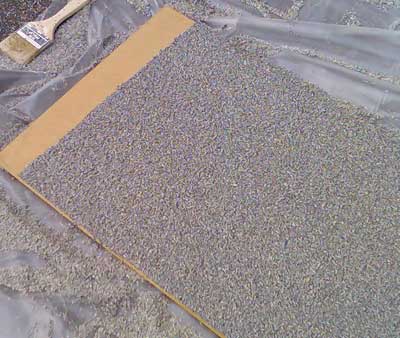
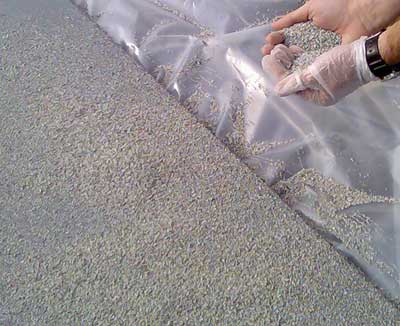
Grit to excess and collect for re-use. When dry brush off excess grit.
Call David on 01626 872886 for calculation of your Brake Roller cleaning and finishing needs.
Discuss the Grades of Grit available to ensure satisfaction.
Click for Resins and Grits in our Order Page
OUR Order Page
- RESINS Order Page - this Site, for Epoxies and other building repair resins
- TANKING Order Page
- SURVEYING TOOLS Order Page
- MEMBRANE FOR DAMP WALLS & FLOORS Order Page
- FIRE PAINTS Order Page
- RUST CONTROL Order Page
Contact I History I Links I Privacy Policy | Returns Policy I Resins Order Page | Technical | References
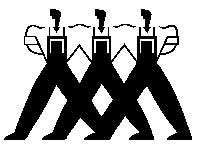
Property Repair Systems
T: 01626 872886
E: Mail us help@propertyrepairsystems.co.uk
Site written by: David Moore
David Moore, B.A. (Hons.), C.T.I.S., C.R.D.S. Technical Author
Google+
Other Property Repair Systems Sites:
www.drywallandfloor.co.uk - membranes for lining damp walls, floors, basements and cellars
www.fire-door-paint.co.uk - upgrade doors to 30 minutes fire resistance
www.joist-repair.co.uk - how to quickly repair joists and beams of any size
www.propertyrepairsystems.co.uk - our Home Site
www.steel-fire-paint.co.uk - treat steel with Intumescent Paint to provide fire protection
www.timber.org.uk - systems of repair, with step by step methods
www.timber-repair.co.uk - how to repair timber beams